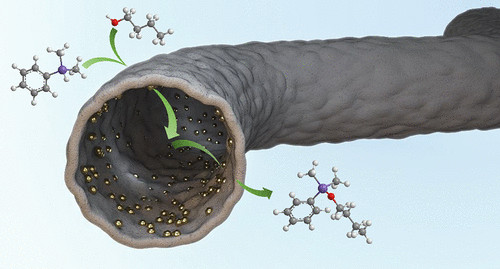News
Poly(p-xylylene) Nanotubes Decorated with Nonagglomerated Gold Nanoparticles for the Alcoholysis of Dimethylphenylsilane
27.04.2020
Julia Kronawitt, Martin Dulle, Holger Schmalz, Seema Agarwal, Andreas Greiner
ACS Appl. Nano Mater. 2020, 3, 3, 2766-2773 https://doi.org/10.1021/acsanm.0c00103

Nanoparticles immobilized on protective polymer supports are highly attractive for various applications in industrial processes. However, nanoparticles tend to agglomerate during the preparation of the polymer supports because of often used harsh conditions and thus lose their specific functionalities, like the catalytic active surface. Here, we report a method that solves the agglomeration and loss of activity by a sacrificial intermediate polylactide (PLA)/gold nanoparticle (AuNP) composite material that was coated with poly(p-xylylene) (PPX) and the selective removal of the PLA resulting in PPX/PLA/AuNP composite mesotube nonwovens with nonagglomerated gold nanoparticles on the inner walls of the polymer tubules. The immobilized AuNP were characterized extensively by electron microscopy and small-angle X-ray scattering (SAXS). With this system, we introduce carriers for nonagglomerated nanoparticles for use in heterogeneous catalysis. The functionality of the composite mesotubes was probed by a model catalytic reaction and compared quantitatively to other nanoparticle-based catalytic systems. The reaction rates, turn over frequencies, Au leaching, permeation of reagents specifically into the tubules, and the reusability were quantified in detail. We report that, in the catalytic model reaction with a gold loading 350 times lower than that of the state-of-the-art composite tubes with agglomerated AuNPs, the composite tubes offer a reaction rate 5 times higher. This system was also validated to work with the catalytic reduction of acetophenone, which is an important industrial reaction for the styrene production. Thus, this system, which shows reusability, stability against common solvents, no agglomeration of AuNPs, and no catalyst leaching, marks major progress toward the translation of high-efficiency nanoparticle catalysis to industrial use and the potential of transfer of other nanoparticle applications like sensoring.

